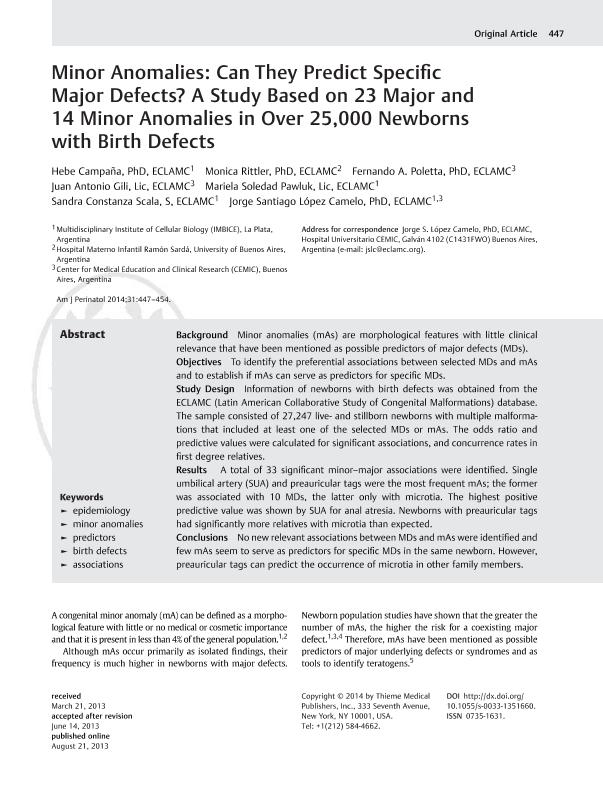Artículo
Minor Anomalies: Can They Predict Specific Major Defects? A Study Based on 23 Major and 14 Minor Anomalies in Over 25,000 Newborns with Birth Defects
Campaña, Hebe; Rittler, Monica; Poletta, Fernando Adrián ; Gili, Juan Antonio
; Gili, Juan Antonio ; Pawluk, Mariela Soledad
; Pawluk, Mariela Soledad ; Scala, Sandra Constanza; Camelo, Jorge Santiago López
; Scala, Sandra Constanza; Camelo, Jorge Santiago López
 ; Gili, Juan Antonio
; Gili, Juan Antonio ; Pawluk, Mariela Soledad
; Pawluk, Mariela Soledad ; Scala, Sandra Constanza; Camelo, Jorge Santiago López
; Scala, Sandra Constanza; Camelo, Jorge Santiago López
Fecha de publicación:
06/2013
Editorial:
Thieme Medical Publ Inc
Revista:
American Journal of Perinatology
ISSN:
0735-1631
Idioma:
Inglés
Tipo de recurso:
Artículo publicado
Clasificación temática:
Resumen
Background Minor anomalies (mAs) are morphological features with little clinical relevance that have been mentioned as possible predictors of major defects (MDs). Objectives To identify the preferential associations between selected MDs and mAs and to establish if mAs can serve as predictors for specific MDs. Study Design Information of newborns with birth defects was obtained from the ECLAMC (Latin American Collaborative Study of Congenital Malformations) database. The sample consisted of 27,247 live- and stillborn newborns with multiple malformations that included at least one of the selected MDs or mAs. The odds ratio and predictive values were calculated for significant associations, and concurrence rates in first degree relatives. Results A total of 33 significant minor–major associations were identified. Single umbilical artery (SUA) and preauricular tags were the most frequent mAs; the former was associated with 10 MDs, the latter only with microtia. The highest positive predictive value was shown by SUA for anal atresia. Newborns with preauricular tags had significantly more relatives with microtia than expected. Conclusions No new relevant associations between MDs and mAs were identified and few mAs seem to serve as predictors for specific MDs in the same newborn. However, preauricular tags can predict the occurrence of microtia in other family members.
Palabras clave:
Epidemiology
,
minor anomalies
,
predictors
,
birth defects
Archivos asociados
Licencia
Identificadores
Colecciones
Articulos(SEDE CENTRAL)
Articulos de SEDE CENTRAL
Articulos de SEDE CENTRAL
Citación
Campaña, Hebe; Rittler, Monica; Poletta, Fernando Adrián; Gili, Juan Antonio; Pawluk, Mariela Soledad; et al.; Minor Anomalies: Can They Predict Specific Major Defects? A Study Based on 23 Major and 14 Minor Anomalies in Over 25,000 Newborns with Birth Defects; Thieme Medical Publ Inc; American Journal of Perinatology; 31; 6; 6-2013; 447-454
Compartir
Altmétricas



